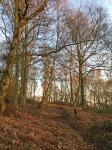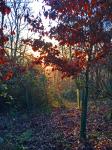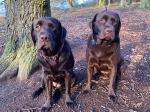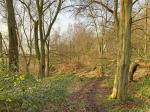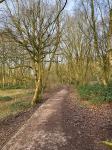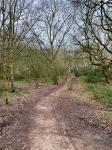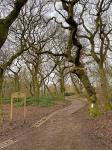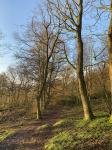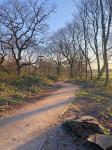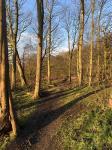Brayton Barff Through the Seasons.
Set in the Vale of York, South West of the market town of Selby and between the villages of Thorpe Willoughby and Brayton, lies Brayton Barff, a sandstone Hill approximately one hundred and fifty feet in height which was formed by glacial movement during the last Ice Age. It is a significant landmark in an otherwise flat landscape.
Today the site is primarily owned by Yorkshire Water with Selby District Council owning a small patch of the land adjacent to the A63 Selby bypass. A large underground reservoir occupies the centre of the site which delivers water to around 4.7 million customers throughout Yorkshire.
Within the Barff woodland over 40% of the trees are Sessile Oak which are generally found in semi natural woodlands in the north of the country. These trees are so called because its acorns are not held on stalks, like those of the English Oak (Pedunculate), but attached directly to the outer twigs. There are also several English Oak trees as well as some cross-hybrid oaks. These trees are known to support many species of flora and fauna, invertebrates, mosses, lichen and fungi.
During the Victorian times it is thought that the shipbuilders on the east coast would come over to the Barff for selected cuts of timber to build their sea going vessels.
The Barff also has a variety of other trees including Silver Birch, Beech, Sycamore, Holly, Rowan, Scots Pine, Alder, Hawthorne and European Larch. There are also several Yew, Willow, Hazel, Horse Chestnut and Wych Elm. As with similar woodlands there are a variety of bushes, including Honeysuckle, Elderberry, Gorse, Broom and Buddleia.
The history of Brayton Barff is quite vague, apparently during 1803 a beacon was lit on the Barff when the country was threatened with an invasion by Napoleon. In May 1935, to celebrate King George V's Silver Jubilee, a Bonfire was lit on the Barff as part of the celebrations.
Early issues of Ordnance Survey Maps dated 1903 clearly show a rifle range on the Barff, extending out to Mill Lane. During the 
Between 2001 – 2004 the A63 Selby bypass, 10km twin lane single carriageway was constructed which severed the South West corner of the Barff, adjacent to Selby Golf Course and resulted in a slight redesign of several holes on the golf course. Wooden fencing was erected as a result of this new road running alongside of the Barff and a footbridge constructed over the ‘new road’ following the line of the Bridal way which extends from Mill Lane. Around 2005/2006 a definite 2metre wide limestone aggregate footpath was laid forming a circular path around the outer edges of the woodland. This footpath is approximately 1.2 miles in length and takes about 30 minutes to circumnavigate at a leisurely pace.
In 2012 the Barff was declared an Ancient Oak Woodland and as such throughout 2012 and 2013 significant work had been carried out by the relevant agencies to cut and remove large swathes of non-native trees, creating at that time huge scars on the landscape. Some three years later the planting of the native trees have become well established and are flourishing. Ongoing maintenance work on the footpath around the bottom of the Barff was completed during the Summer of 2016.
A second phase of woodland maintenance commenced during the Autumn of 2019 with the removal of many old and diseased trees and the cutting back of the Gorse and Broom bushes, especially adjacent to the ‘bypass trail’, this work continued through till March 2020 with re planting continuing into April 2020.
Brayton Barff is a popular site for walkers and bird watchers alike and a path circling the outer perimeter of the Barff makes a pleasant thirty minute walk, giving views looking over towards Selby and the village of Brayton as well as the power stations of Drax and Eggborough..jpg)
For the early risers it is a great place to see some stunning sunrises over the villages of Brayton looking towards Drax Power Station, the same with the Sunsets looking over towards Eggborough and Monk Fryston.
The Barff changes with the Seasons and every visit can reveal something new, the woodland is a haven for wildlife. Records show that since 1982 one hundred and twelve species of bird have been seen in the woodland and at least 40 of those have bred here, including Tawny Owl, Buzzard, Green Woodpecker, Spotted Flycatcher, Goldcrest and Nuthatch to name just a few. On average over 70 species of bird are recorded each year. Further details of the bird life on the Barff can be found on the Brayton Barff Group Facebook page, especially the posts from Derek Cooper. Today ‘The Friends of Brayton Barff group’ led by Derek and a small team of volunteers help keep and maintain the cleanliness of the site as well as recording the wildlife and bird sightings.
The Barff is also home to fifteen different species of mammals, including Muntjac Deer, Pipistrelle Bat, Fox, and Field Vole.
Over eighty species of plant and wildflowers have been recorded, included Bee Orchid, Northern Marsh Orchid, Wood Anemone, Marsh Ragwort, Bluebell, White Bluebell, Bittersweet and Purple and White Foxgloves. Over twenty species of Butterfly have been recorded, including Marbled White, Brown Angus, Speckled Wood, Comma and Brimstone.
During the Autumnal months fungi thrives in this woodland environment, species including Fly Agaric, Beefsteak Tree Fungi, Chicken of the Wood, Sulphur Tufts, Stinkhorn, Ink cap, Puffballs and Hoof Bracket are just some of the many varieties that can be found here.
Click on the galleries shown below to expand the albums.
February 2020
February 2020 will go down in the history books as the wettest February on record. On the top of Tap Hill, adjacent to the perimeter fence the ground was a muddy quagmire as a result of the forest machinery, spreader plates had been used initially to off load the vehicle but during its time on the Barff it caused significant damage to most areas it was used.
The main circular footpath around the perimeter of the woodland remained relatively dry albeit wet and slightly muddy from the fallen leaves.
This part of North Yorkshire is renown for its westerly winds and February started with four days of westerlies, interspersed with rain and sunny periods and the occasional light overnight frost.
On Sunday 9th February we had an exciting walk around the Barff, it was very windy, and several trees had been damaged as a result. Named ‘Storm Ciara’ by the ‘Met Office’, we had a further few more days of storm force winds and heavy rain, so heavy in fact that I had to put Meg and Gracie in their winter jackets for their walks! Unfortunately, as a result of the heavy and persistent rain significant flooding was happening in our neighbouring villages. The wet and windy weather continued and on Saturday 15th another strong wind was categorised as ‘Storm Dennis’, bringing with it even wetter weather. Alas flooding was reported in various areas around the country resulting in people having to leave their flooded houses. Closer to home problems arose with standing water, fallen trees and landslips, The road bridge over the river Aire on the main A19 at Chapel Haddelsey was flooded and damaged due to the volume of water, which resulted in the road being closed. The Strong winds persisted through the rest of the month bringing down many rotten tree branches, throughout this time the forestry work continued on the Barff throughout the month with cutting out and pruning.
Monday 24th February saw our first snow of the winter here in North Yorkshire, the snow fell in the early hours of the morning and by the time most people had risen from their sleep the snow had turned to rain, the rain and sleet showers continued for the next two days. Due to the cold, wet and miserable conditions the dogs had their winter jackets on for a couple of days again, Meg & Gracie, like most dogs, can withstand quite severe conditions and have done in the past, but when all three elements are combined at once, snow, rain and strong winds over a period of a couple of hours can cause them to get cold very quickly and as in humans bring on hyperthermia, fortunately the wind chill factor wasn’t as bad as it could have been had we been in the Cairngorm mountains.
As a consequence of all the rain and relatively mild conditions the Barff is beginning to come out of its winter hibernation period, the Bluebells for example are slowly beginning to poke through the woodland floor, foxgloves and daffodils are beginning to push through and the Gorse is flowering too.
Just to add insult to injury, on Friday 28th February the country and North Yorkshire was hit with yet another storm – Storm Jorge, which brought strong winds and heavy rain across all parts of the UK over the weekend, fortunately this storm was less severe than from storms Clara and Dennis, but flooding problems continued across the county.
A much bigger concern though is that the Coronavirus has been imported into the country and claimed the lives of 20 people in the UK as I write this note (at the end of February). The implications from this virus spreading throughout the country are extremely serious and could be quite devastating to us all, until a remedy can be found let us hope that a cure can be found quickly.
|




